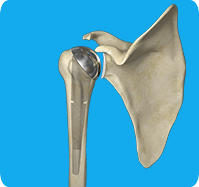
Arthritis of the Shoulder
The term arthritis literally means inflammation of a joint but is generally used to describe any condition in which there is damage to the cartilage. Damage of the cartilage in the shoulder joint causes shoulder arthritis. Inflammation is the body's natural response to injury. The warning signs that inflammation presents are redness, swelling, heat, and pain.

Rotator Cuff Arthropathy
The rotator cuff consists of 4 muscles that stabilize the ball and socket joint of the shoulder during movement. Large tears in the rotator cuff can lead to joint instability and slipping of the ball (end of the upper arm bone or humerus) out of the socket (the glenoid fossa of the shoulder). Over time, this leads to a condition called rotator cuff arthropathy, which is a form of wear-and-tear arthritis caused by the rubbing of the ball against the outer rim of the glenoid.

Acromioclavicular (AC) Joint Injuries
The acromioclavicular (AC) joint in the shoulder is very important for shoulder strength, motion, and maintaining shoulder position. The joint is stabilized by various ligaments and a capsule, which can cause pain and affect normal joint function if damaged.

Revision Shoulder Replacement
Revision surgery is usually performed under general anesthesia. You are positioned in such a way as to allow all possible variations in the treatment plan. Incisions are made to gain optimal access to the problem and usually follow previous incisions with extensions made as necessary.

Shoulder Joint Replacement
Total shoulder replacement surgery is performed to relieve symptoms of severe shoulder pain and disability due to arthritis. In this surgery, the damaged articulating parts of the shoulder joint are removed and replaced with artificial prostheses. Replacement of both the humeral head and the socket is called a total shoulder replacement.

Minimally Invasive Shoulder Joint Replacement
Shoulder joint replacement is a surgical procedure that replaces damaged bone surfaces with artificial humeral and glenoid components to relieve pain and improve functional ability in the shoulder joint.Shoulder joint replacement is a surgical procedure that replaces damaged bone surfaces with artificial humeral and glenoid components to relieve pain and improve functional ability in the shoulder joint.

Reverse Shoulder Replacement
Conventional surgical methods such as total shoulder joint replacement are not very effective in the treatment of rotator cuff arthropathy. Reverse total shoulder replacement is an advanced surgical technique specifically designed for rotator cuff tear arthropathy, a condition where you suffer from both shoulder arthritis and a rotator cuff tear.

Partial Shoulder Replacement
Partial shoulder replacement, also called shoulder hemiarthroplasty, is a surgical procedure during which the upper bone in the arm (humerus) is replaced with a prosthetic metal implant, whereas the other half of the shoulder joint (glenoid or socket) is left intact. Partial shoulder replacement is usually indicated for a severe fracture or arthritic conditions of the shoulder, in which only the humeral head or ball of the joint is damaged and the glenoid socket is normal or intact.

Ream and Run Shoulder Arthroplasty
Ream and run shoulder arthroplasty, also known as shoulder hemiarthroplasty with non-prosthetic glenoid arthroplasty, is a novel type of shoulder arthroplasty (replacement) procedure employed for the treatment of severe arthritis of the shoulder. Shoulder arthritis is a condition in which the cartilage on the glenoid and humeral head deteriorates resulting in significant pain and stiffness of the shoulder joint.
